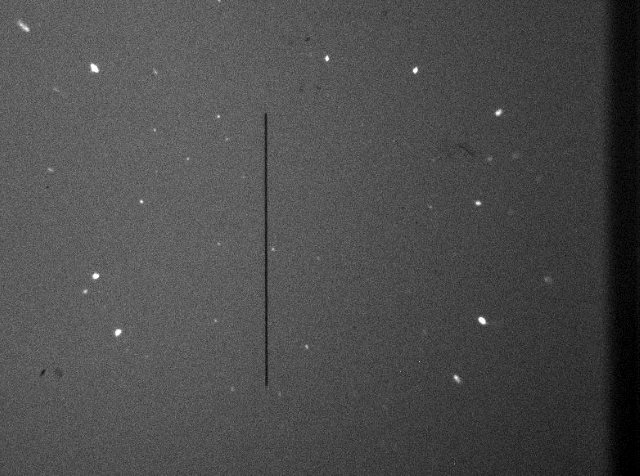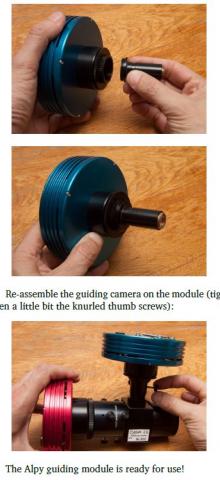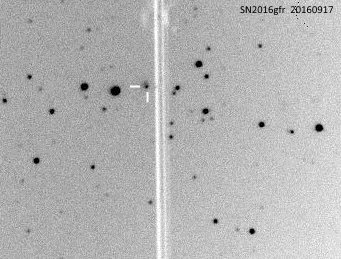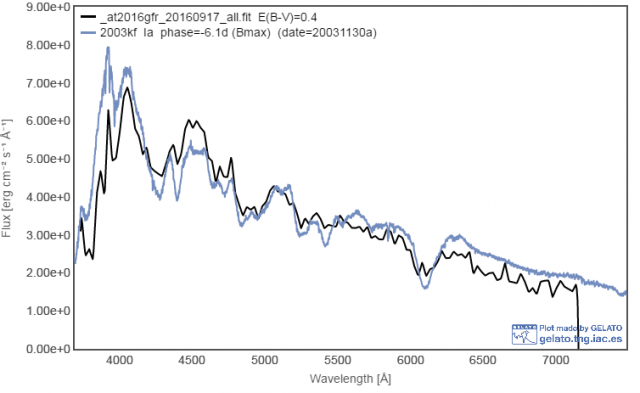Forum Replies Created
-
AuthorPosts
-
 Robin LeadbeaterParticipant
Robin LeadbeaterParticipantHi Steve,
I am not sure I follow what you have done.
To calculate the instrument response using a MILES star, you take a spectrum of the actual MILES star you have chosen, not one which happens to have the same spectral class. (The actual spectral class does not matter as long as it is a hot star, it is probably unreliable anyway!) That way you end up with a spectrum of the MILES star as measured with your equipment which you can directly compare with the one of the same star in the library, which was measured and calibrated by a professional. The ratio of the two is your instrument response.
You can then use this instrument response to correct a spectrum of any target measured using your setup, (even if you have no idea what the spectrum will look like) to produce a fully calibrated spectrum. (With one caveat – you should chose a MILES reference star at similar altitude to your target so the effect of atmospheric extinction is the same.)
Cheers
Robin
 Robin LeadbeaterParticipant
Robin LeadbeaterParticipantHi Tony,
With your setup of 235mm aperture and f6.3, the star image size FWHM with 3 arcsec seeing will be 26 um so slightly larger than the slit width so there will be a small amount of the star overlapping the slit and it will not completely disappear unless your seeing is very good. You should see a significant drop in brightness though as the star crosses the slit. The trick is not to over expose the guide star image. Take a look at the short videos on this page of Christian Buil’s. It gives an idea of what you should see when correctly (fente3.wmv) and over exposed (fente4.wmv). (In French but Google translates well.)
http://www.astrosurf.com/aras/slit/method.htm
If you still do not see the star drop into the slit, your guide camera may not be precisely focused on the slit. This should be checked first before trying to focus the telescope.
Cheers
Robin
 Robin LeadbeaterParticipant
Robin LeadbeaterParticipant Robin LeadbeaterParticipant
Robin LeadbeaterParticipantThe key thing is that if your star image is already comparable/smaller than the fixed slit width, adding a focal reducer to reduce the focal length will not give you any more throughput or resolution even though the spectrograph might be able to accept a faster beam. You just end up adding more unwanted glass and risk chromatic aberrations.
As an example, taking Steve’s 120mm f7 scope, the 23um ALPY slit covers 5.6 arcsec of sky so in typical seeing the star is already smaller than the slit and reducing the focal length further will give no benefit. (If it was possible to reduce the slit width, you could take advantage of the extra potential resolution but the ALPY slit only has a single fixed slit width)
If we consider my setup though (An f10 C11 with 280mm aperture) The slit is 1.7 arc sec and my seeing is typically 3 arc sec so unless I use a reducer I lose a lot of light at the slit. At f5 the slit is 3.4 arcsec and a much better match to my seeing
Cheers
Robin
 Robin LeadbeaterParticipant
Robin LeadbeaterParticipantSince we are near Halloween, have a look at these pages concerning focal reducers on Christian Buil’s site.
http://www.astrosurf.com/buil/isis/lisa_ri/index_en.htm
http://www.astrosurf.com/buil/dispersion/atmo.htm
The first one describes precautions to be taken with focusing using a focal reducer with a LISA but the second one, looking at the effects of the interraction between chromatic aberrations and atmospheric dispersion is particularly frightening !
Robin
 Robin LeadbeaterParticipant
Robin LeadbeaterParticipantHi Steve,
With a 120 mm aperture scope, depending on your seeing, it might not be worth reducing all the way to f 4/5. In fact it might even be counter productive as your star image might be so much smaller than the slit width that it “rattles around” in the slit making it difficult to guide on the slit as there will be little or no overspill. It could also give potential wavelength calibration issues as the star location rather than the slit itself will start to define the spectrum position. I suggest measuring some star FWHM under typical seeing conditions first and comparing this with the ALPY slit width (23um). The optimum is to have the slit ~equal to the FWHM
Re the ALPY focal ratio, I think the aperture of the ALPY optics will accept an f4 beam but like most optics, they work better stopped down a bit. I suspect you will get a sharper spectrum and potentially squeeze a bit more resolution out at f5 compared with f4, particularly at the ends of the spectrum. This is certainly true of the LHIRES.
Cheers
Robin
 Robin LeadbeaterParticipant
Robin LeadbeaterParticipantHi David,
Which camera do you have? Some sensors benefit from deep cooling eg the Kodak KAF CCDs. Others, like the Sony CCD, less so. The ATIK cameras I have used only cool ~25C below ambient so I run at -10C all year round which gives negligible thermal noise and saves me worrying about the risk of non matching darks/bias. Incidentally if you do cool to very low temps, watch out for ghost residual images in following exposures. This can happen for example if you take a faint spectrum image after an overexposed calibration lamp image. I have never seen it myself at -10C but it was a problem than plagued a pro-am campaign I was involved in where they were using KAF CCD cooled to a low temp.
Cheers
Robin
 Robin LeadbeaterParticipant
Robin LeadbeaterParticipantThanks Jeremy,
Three confirmations so far this year (bme,gfr and gxp) This latest spectrum was also a test of my camera upgrade from ATK314 to the more sensitive ATK428 which seems to be working well.
Robin
 Robin LeadbeaterParticipant
Robin LeadbeaterParticipantHi Steve,
Have you been able to discuss this with the original author? Perhaps if you can reach an agreed view, an author’s amendment to the paper might be appropriate and acceptable to the editor, avoiding the risk a protracted discussion. Although not strictly peer review, ArXiv can indeed be rather good in this respect where the on line version can reference the conventionally published version and be subsequently revised with the original version still accessible. (and useful for us poor amateurs unable to access papers behind paywalls of course!) It still would not allow easy tracking back from the Journal version though unless pre published on arXiv and referenced in the Journal version. I see some journals actively encourage authors to mirror their papers on arXiv. I am not sure what JBAA view would be on this however.
Cheers
Robin
 Robin LeadbeaterParticipant
Robin LeadbeaterParticipantHi Steve,
In practise critiques of papers in the way you describe are rarely published in any scientific journals. Where the findings of a paper are questioned it is usual to do so through the publication of another paper, offering further evidence which may lead to alternative conclusions. The scientific community is then left to judge the validity of the two bodies of work and carry out further investigations to clarify the situation.
If however you are not ready at this stage to offer alternative evidence by way of a formal paper and just want to test out your thoughts on specifically why “the process used in the paper to generate the estimates from the measured data” might not be sufficiently robust, even though the referees of the paper apparently thought they were, then I have found an informal discussion with ones peers as could be done here, can be a very effective in clarifying ones thinking.
Cheers
Robin
 Robin LeadbeaterParticipant
Robin LeadbeaterParticipantDiscussing a paper via the letters page in a bi-monthy journal all seems rather 19th century to me. Given that we are here using this forum, does anyone else find it rather ironic and a little odd that we are discussing the “meta-subject” rather than the subject itself?
Robin
 Robin LeadbeaterParticipant
Robin LeadbeaterParticipantHi Tony,
I can’t see the attachment for some reason (was it below the maximum 640×48 size?) but my field has significant off axis coma, something I plan discussing with Francois at the workshop. I believe it is a feature of the guider optics and it is ok close to the axis where the slit is but I would be interested to explore if it could be improved as sometimes I would like to be able to use guide stars well off axis. I have attached an example guider frame from my setup
The shadowing might be because the mirror slit in the ALPY module is not quite aligned at the optimum angle relative to the guider. You can rotate the ALPY module to optimise the illumination and then rotate the guide camera to align the slit in the field. My slit is slightly offset. I am not sure where this arises, possibly in the camera coupling. These will be good subjects for the workshop however when we have Francois to demonstrate how to set the spectrograph up optimally.
Cheers
Robin

 Robin LeadbeaterParticipant
Robin LeadbeaterParticipantHi Nick,
Doesn’t it just screw onto the male C thread ?
(This photo in the manual shows a T threaded camera with a C to T adapter)

 Robin LeadbeaterParticipant
Robin LeadbeaterParticipantIf you switch a calibration lamp on (or in twilight if you don’t have the calibration module) you can see the slit in the guider image. I use PHD2 for guiding and note the XY position in pixels of the point on the slit where I want to place the star. If everything is screwed down tight the spectrograph is sufficiently stable that I can then set that location in PHD (or an offset from that location if guiding on a field star, the offset having been measured on a stack of longer exposure guider images)
Robin
 Robin LeadbeaterParticipant
Robin LeadbeaterParticipantHi Tony,
Yes I will be there. I have some techniques which we can discuss there which should help get your fainter targets on the slit. (Most targets with my modified ALPY 200 are so faint that they are not visible in the guider image at all.)
Robin
 Robin LeadbeaterParticipant
Robin LeadbeaterParticipantHi Gary,
ATel 9418 makes the suggestion that the H alpha emission at least may be present at times weakly even in the normal quiescent state and stays at the same absolute strength but becomes more obvious as the continuum drops (ie constant flux but increasing Equivalent Width relative to the continuum) My spectrum is not really good enough to confirm this though.
I did also have a try with the ALPY at normal resolution (Thanks to the support from the Harold Rildley grant I now have the capability to switch resolution more easily) but the SNR at this magnitude is too poor to show any more than the general continuum shape. I wonder if the Asiago team are still keeping an eye on it with the 1.2m telescope?
Robin
 Robin LeadbeaterParticipant
Robin LeadbeaterParticipantYou missed the full page ad on the back cover of the October Journal ?
 Robin LeadbeaterParticipant
Robin LeadbeaterParticipantHi Steve,
Yes, I plan to be there
Robin
 Robin LeadbeaterParticipant
Robin LeadbeaterParticipantThis time it is the confirming spectrum.
at2016gfr was discovered by Tim Puckett’s amateur team 6 days ago but was embedded in the host galaxy and too faint at mag 17.6 for a spectrum.
When I checked on Saturday there was still no confirming spectrum but it had brightened to around mag 16 so I was able to extract a spectrum (confirming it as a type Ia) using the modified ALPY 200 despite a full moon. Guider image and spectrum (compared with best fit from GELATO) attachedCheersRobin

 Robin LeadbeaterParticipant
Robin LeadbeaterParticipantI have a second hand 2 inch flip mirror sitting in a box, bought on impulse after I saw Bernard Heathcote’s combined spectroscopy/imaging setup a few years ago. I still have vague ideas of mounting the LHIRES and the ALPY together on the C11. The Alpy would need a focal reducer though so there may be issues bringing them to focus, let alone ideally making them parfocal.
Robin
-
AuthorPosts
